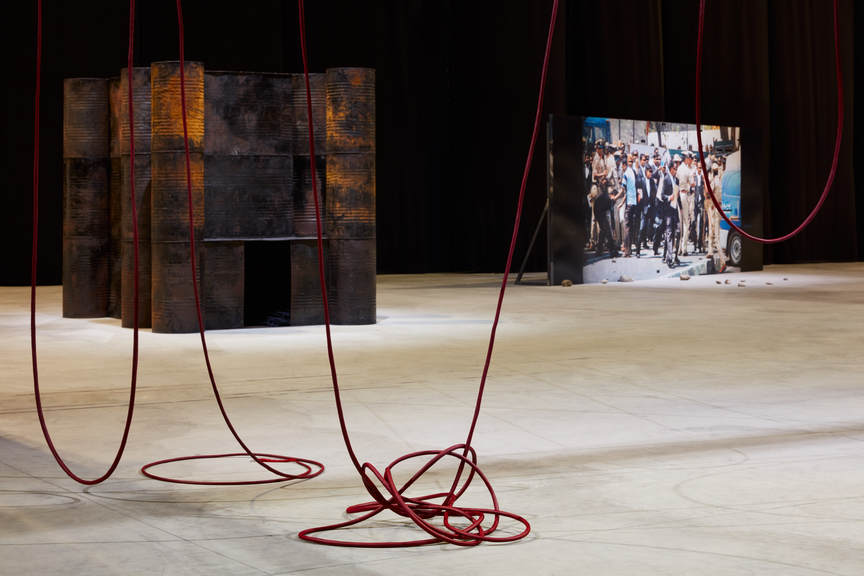-
From Current Issue
-
- Editor’s Letter Fire in the Heart
- Reviews I Gusti Ayu Kadek Murniasih
- Reviews 11th Seoul Mediacity Biennale: “One Escape at a Time”
- Dispatch Networked China
- One on One Monira Al Qadiri on Yukio Mishima
- Essays The rise of independent art spaces in pandemic-era Shanghai
- Features Tuan Andrew Nguyen
- Table of Contents
- Web Exclusives
- Archive
- Subscribe

R
E
V N
E
X
T
Installation view of SHEELA GOWDA’s And That Is No Lie, 2015, and It Stands Fallen, 2015–16, metal, fabric, rope, wire, dimensions variable, at “Remains,” Pirelli HangarBicocca, Milan, 2019. All photos by Agostino Osio. All images courtesy the artist and Pirelli HangarBicocca.
Though trained as a painter in the modernist tradition, Sheela Gowda is best known today for her installations incorporating commonplace objects and unconventional materials including hair, cow dung, incense and tar, all sourced from her native India. Gowda’s shift in the 1990s toward utilizing street materials was undergirded by a desire to relate to and comment on local issues in a developing India, from labor and industrialization to religious fundamentalism and women’s rights. “Remains,” Gowda’s solo Italian debut at Milan’s Pirelli HangarBicocca, brought together 22 new and restaged works spanning installation, sculpture, watercolor and print. Scattered across the vast main hall, the works were arranged and reinterpreted with an eye to the venue’s industrial architecture, raising comparisons that foregrounded central concerns of Gowda’s practice: an engagement with materials’ references to social reality and an ongoing formal interest in line and abstract form.
Installation view of SHEELA GOWDA’s Kagebangara, 2008, tar drum sheets, tar drums, mica tar sheet, mica, tarpaulin, dimensions variable, at “Remains,” Pirelli HangarBicocca, Milan, 2019.
Kagebangara (2008), an installation comprising rectangular rusty metal sheets, two bright blue and yellow squares of tarpaulin, and several stacked and fallen tar drums, was one of a number of works where Gowda employs materials recovered from building sites in Bangalore. The composition of metal sheets and tarpaulin, hung against a backdrop of metal scaffolding, recalls modernist geometric abstraction in its use of modular shapes and primary colors. At the entrance of a low shack built with battered metal sheets and tar drums were bowls filled with shiny silica, to suggest collected rainwater. Kagebangara was inspired by the cramped temporary dwellings often built by immigrant workers who tarmac roads in Bangalore, and pondered, from a local perspective, on migrant workers’ toil in the global rush to overbuild.
Installation view of SHEELA GOWDA’s What Yet Remains, 2017, metal drum sheets, metal bowls, dimensions variable, at “Remains,” Pirelli HangarBicocca, Milan, 2019.
A similar point was made in What Yet Remains (2017), comprising a large number of bandlis aligned in clusters on the concrete floor. Bandlis, circular bowls commonly used to pass building materials from hand to hand, are repurposed from metal drums that are first flattened into sheets and then punched through to obtain circular discs. These are subsequently hand-beaten into vessels, multicolored examples of which were displayed alongside the perforated metal offcuts, lying on the ground or folded into minimalist, standing sculptural forms. Beautifully arranged, the installation speaks of fading craft traditions and of the ingenious reuse of materials by the thousands of anonymous workers who contribute to the rapid development of cities.
The formal concept of line took different interpretations in two pieces that were placed in dialogue next to each other. Mortar Line (1996), a minimalist-looking floor piece, consists of a curving double line of bricks made of pressed cow dung. Red kumkum, a pigment used in religious rituals, was used as filling, or mortar, between the bricks. Gowda often uses cow dung in reference to women’s labor, as women in rural areas work cow’s excrement into patties to sell as manure and fuel. Cows are considered sacred animals in Hinduism, a religion that advocates non-violence yet has become embroiled in right-wing extremism, culminating in attacks predominantly on beef-eating Muslims. Politicized militant Hinduism is hinted at in Gowda’s use of materials carrying religious connotations, and the titular pun alluding to mortar attacks in warfare.
By contrast, And… (2007) expands vertically, and features several long, flexible ropes dangling from the ceiling to form an abstract composition of meandering lines. The work was made by pulling 300 meters of red thread through the eye of 108 needles as commentary on the laborious nature of conventionally “female” tasks such as sewing. Covered in a blood-red paste of glue and kumkum, the ropes recall blood vessels, and arouse a sense of mild discomfort as one’s eye falls on the cords’ loose ends, from which batches of silver needles dangle.
Showcasing Sheela Gowda’s sensitivity in interpreting the world through the communicative value of materials, “Remains” also emphasized her ability to focus on coherent stylistic choices. The ingenious and poetic use of formal language guides the viewer toward the wider social implications embedded in her work, while always keeping open multiple possibilities of interpretation.
Sheela Gowda’s “Remains” is on view at Pirelli HangarBicocca until September 15, 2019.
To read more of ArtAsiaPacific’s articles, visit our Digital Library.


















